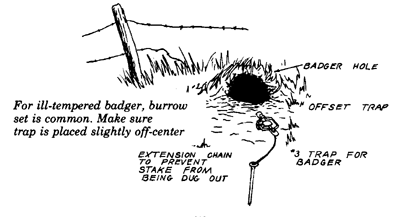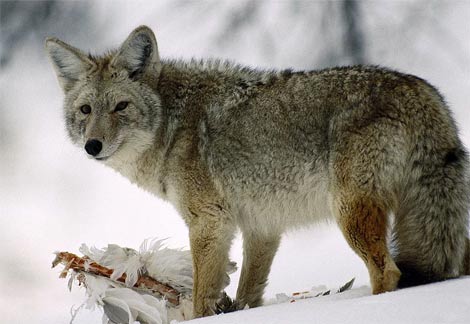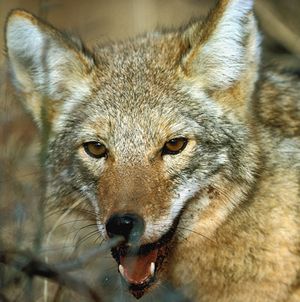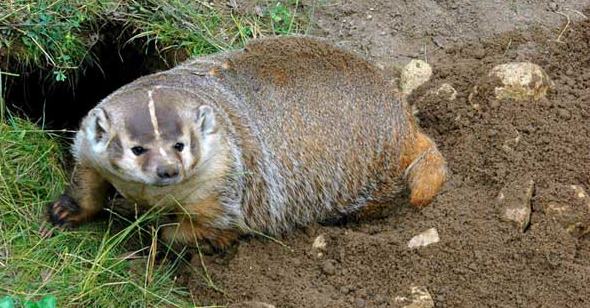Among midwestern states, the bobcat is protected in Iowa, Illinois, Indiana, Ohio, and in most counties of Kentucky. It is managed as a furbearer or game animal in the plains states. Western states generally exempt depredating bobcats from protected status. They can usually be killed by landowners or their agent. In the more eastern states and states where bobcats are totally protected, permits are required from the state wildlife agency to destroy bobcats. Consult with your state wildlife agency regarding local regulations and restrictions.Â
Category: Predators & Varmints
Idenifying Badger Sign
Most damage caused by badgers results from their digging in pursuit of prey. Open burrows create a hazard to livestock and horseback riders. Badger diggings in crop fields may slow harvesting or cause damage to machinery. Digging can also damage earthen dams or dikes and irrigation canals, resulting in flooding and the loss of irrigation water. Diggings on the shoulders of roads can lead to erosion and the collapse of road surfaces. In late summer and fall, watch for signs of digging that indicate that young badgers have moved into the area. Continue reading Idenifying Badger Sign
Calling and Shooting Coyotes
Coyotes may respond to predator calls. Calling, like other methods of predation control, should be used sparingly and only when needed. Coyotes can be called at any time of the day although the first couple of hours after dawn and the last few hours before darkness are usually best. Call in areas where there are signs of coyotes, such as tracks or droppings. Continue reading Calling and Shooting Coyotes
Trapping Badgers Using Live Traps
Badgers are strong animals that can cause a lot of damage. They can den under homes and buildings and create problems for residents. The successful trapping of badgers can eliminate or prevent these problems. Badgers can be removed by using live traps and/or foothold traps set like those for coyotes. Snares have been used with mixed success, but they can be effective in the right situations.
Badgers often return to old diggings, so this is always a great place to trap. A good bait for badgers is a dead chicken placed within a recently dug burrow. Fur trapping may reduce badger populations locally, but badger pelts are generally of little value and most badgers are caught incidentally.
Foothold traps in the sizes #3 or #4 are adequate to hold even a large badger. However, rather than staking the trap to the ground, it is better to attach it to a drag such as a strong limb or similar object that the badger cannot pull down into its burrow. The problem with stationary stakes is that badgers will often dig in a circle around a stake, sometimes enough to loosen the stake and drag the trap away.
Badgers are neat animals when living in their natural habitat, but removal through trapping is sometimes necessary for both the badger and people. Before trapping, I recommend trying to “bother” the badger with enough activity to push the animal out of the area. This can include the continuous playing of a radio close to their den or continual filling in of their den. This harassment may be enough to get the badger to leave the area and move off to better, more appropriate habitat.

Setting Snares for Coyotes
Snaring is the technique of setting a steel-cable loop in an animal’s path to capture it by the neck, body, or leg. Snares usually consist of a 2.5- to 10foot (0.75- to 3.0-m) long piece of galvanized aircraft cable containing a slide lock that forms a loop in the cable (Fig. 31). On short snares, a swivel to prevent twisting and breaking the cable is attached to the end of the cable opposite the loop. On longer snares, swivels can be located near the middle of the cable and at one end. Continue reading Setting Snares for Coyotes
Repelling Coyotes

Coyotes rely heavily on visual cues while stalking, chasing, and killing their prey. Taste and smell are of lesser importance in actually making the kill. These factors may in part account for the fact that the repellent compounds were not able to consistently prevent coyotes from killing, although some of the repellents were obviously offensive to coyotes and prevented them from consuming the killed prey. Several compounds were tested on sheep under field conditions, but none appeared to offer significant, prolonged protection.
If an effective chemical repellent were to be found, the obstacles in bringing it to industry use would be significant. The compound would not only need to be effective, but also persistent enough to withstand weathering while posing no undue risk to the sheep, other animals, or the environment. It would also have to withstand the rigorous Environmental Protection Agency (EPA) approval process.
High-frequency sound has also been tested as a repellent for coyotes, but the results were no more encouraging than for chemical repellents. Coyotes, like dogs, responded to particular sound frequencies and showed some aversion to sounds broadcast within one foot of their ear. Researchers, however, were unable to broadcast the sound a sufficient distance to test the effects under field conditions.
Legal Status of Coyotes

The status of coyotes varies depending on state and local laws. In some states, including most western states, coyotes are classified as predators and can be taken throughout the year whether or not they are causing damage to livestock. In other states, coyotes may be taken only during specific seasons and often only by specific methods, such as trapping. Night shooting with a spotlight is usually illegal. Some state laws allow only state or federal agents to use certain methods (such as snares) to take coyotes. Some states have a provision for allowing the taking of protected coyotes (usually by special permit) when it has been documented that they are preying on livestock.
In some instances producers can apply control methods, and in others, control must be managed by a federal or state agent. Some eastern states consider the coyote a game animal, a furbearer, or a protected species.
